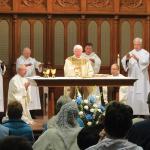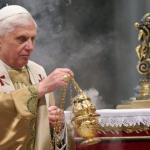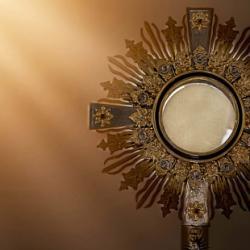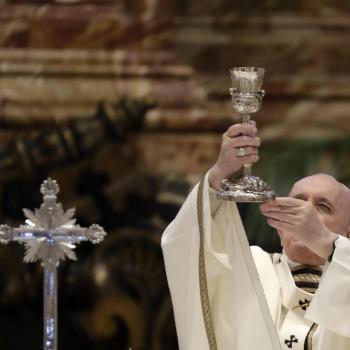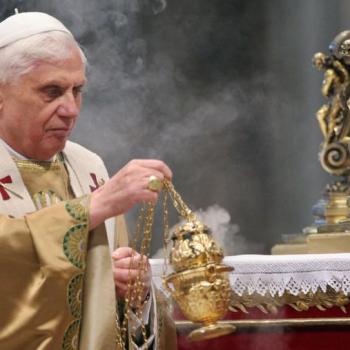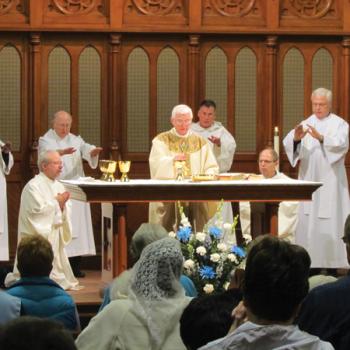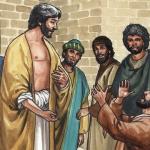Part III: John Paul II and the Liturgical Reforms
Editor’s note: This is the third article in a series by Andrew Likoudis entitled “The Liturgical Reform – Council, Consilium, and Papacy.” Click here for Part 1: “The liturgical path of the Church after Vatican II.” Click here for Part 2: “The Post-Conciliar Era: The Church and the rise of traditionalism.”
Pope St. John Paul II’s pontificate (1978-2005) was marked by significant efforts to continue the liturgical renewal initiated by the Second Vatican Council while addressing the challenges and controversies that emerged in the immediate post-conciliar period. In addition to the issuance of the indult for the limited use of the pre-conciliar Missal, Quattuor Abhinc Annos, and the Motu Proprio Ecclesia Dei, responding to the illicit episcopal consecrations by Archbishop Lefebvre and expanding the use of the same Missal (both controversial actions by the pontiff, the former carried out against the almost unanimous advisement of the episcopate, and the latter, without any consultation),[1] this period saw him continue Pope St. Paul VI’s efforts to address liturgical issues through working with the Consilium, a commission of liturgical experts, theologians, and clergy, to produce a series of “instructions” aimed at guiding the correct implementation of Sacrosanctum Concilium and the refinement of liturgical praxis. These instructions are little-known, but they are the authoritative answer to the polemic that the reform didn’t follow closely enough, the black letter of Sacrosanctum Concilium.
The Five Instructions on the Correct Implementation of Liturgy are:
1. Inter Oecumenici (1964)
This instruction served as the foundational guideline for the immediate implementation of the liturgical reforms. It introduced several significant changes including to language, the orientation of the priest, simplification of the rites, the role of the laity, and liturgical music. One of the specific changes included guiding the introduction of vernacular languages in certain parts of the Mass, particularly the readings and prayers. It also controversially encouraged the priest to face the congregation. This new orientation would be further solidified in the General Instruction of the Roman Missal,[2] which also built on the Congregation for Rites’ 1967 Instruction, directing that Altars be made the focal point of the liturgy, stationed between the priest celebrating the liturgy of the Eucharist, and the laity, so that what takes place on the altar may be clearly seen by all. This document also simplified various rites and reduced repetitions to make the liturgy more concise and focused. It instructed that ornamentation of a church be directed toward noble simplicity rather than ostentation. It also emphasized greater participation of the laity in the liturgy, including more active roles in responses and singing. Significantly, it also encouraged the use of local musical traditions in the liturgy.
2. Tres Abhinc Annos (1967)
This instruction furthered the reform process initiated by Inter Oecumenici. Primarily, it expanded of the use of the vernacular language in more parts of the Mass, including the Eucharistic Prayer. It also modified the Liturgical Calendar and texts and rites, aiming to make them more relevant and understandable, and introduced new Communion practices for both distribution and reception, including the possibility of receiving Communion under both kinds (bread and wine).
3. Liturgicae Instaurationes (1970)
This instruction aimed at reinforcing and consolidating the reforms. It stressed adherence to the reformed Liturgical books, also discouraging unauthorized liturgical innovations. It reiterated the need for active participation by the faithful in the liturgy. It also provided detailed guidelines to bishops and national conferences on how to properly implement the liturgical reforms within their local territories.
4. Varietates Legitimae (1994)
Focused on the inculturation of the liturgy. It recognized the need for liturgical expressions that reflect local cultures, allowing for certain adaptations in liturgical celebrations. This balance between traditional praxis and adaptation was a challenge involving a focus on maintaining the integrity of the traditional Roman Rite while incorporating elements from local traditions, languages, and arts. The document sought to outline the principles and procedures for adapting liturgical texts and rites to different cultural contexts.
5. Liturgiam Authenticam (2001)
This last of the five instructions concentrated on the translation of liturgical texts. It primarily advocated for translations that are faithful to the original Latin texts, both in terms of accuracy and liturgical propriety and also stressed that translations should preserve the sacrality, dignity, and doctrinal precision of the liturgical language. It also emphasized the need for collaboration between bishops’ conferences and the Holy See in the process of translation to ensure unity and fidelity in the liturgical expressions.
The Third Edition of the Roman Missal
In 2000, John Paul II promulgated the Third Typical Edition of the Roman Missal, carrying the reform forward into the Third Millennium and impressing upon anyone who still had any doubts about whether the reform would hold, that this revised order of the mass had the Church’s full backing. This new Missal included revisions to the liturgical calendar, new saints’ feasts, additional prefaces for the Eucharistic Prayers, and improved translations of key theological terms, aided by the guidelines laid out in Liturgium Authenticum. The revised Missal aimed to deepen the faithful’s understanding of the Paschal Mystery dimension of the liturgy, correcting lopsided understandings of the Mass that focused too exclusively on the sacrificial aspect. This, while maintaining the integrity, beauty, and simplicity of the liturgical celebration thus far in its process of reform.
Challenges and Achievements
The period of John Paul II’s pontificate was not without its challenges, however. The Church continued to grapple with the fallout and disorientation that inevitably followed the replacement of the 1962 Missal and the Tridentine form of the Mass. While many welcomed the clarifications and refinements brought by the new Instructions and the revised Missal, others viewed these as insufficient in addressing the perceived liturgical irregularities, abuses, and theological and practical questions that more flexible rubrics, and a new praxis, introduced into the life of the Church. Some of the faithful who had settled into previous forms of the reformed liturgy saw these further Instructions and New Missal as an imposition on the already-established local expressions of the liturgy.
In his Apostolic Letter Vicesimus Quintus Annus: On the 25th Anniversary of the Promulgation of the Conciliar Constitution Sacrosanctum Concilium on the Sacred Liturgy, St. Pope John Paul II acknowledged the difficulties encountered in this period of liturgical renewal. He noted that the changes had not always been accompanied by adequate explanation and catechesis, leading to confusion and resistance in some places.[3] Moreover, he expressed concern about the liturgical abuses that had emerged, causing distress to many.[4]
In response to these challenges, St. John Paul II stressed the liturgical renewal as “the most visible fruit of the whole work of the Council”[5] and continued the call for a faithful implementation in accordance with Sacrosanctum Concilium (and, needless to say, thus also in accordance with the Church’s interpretation of this Constitution, found in its five “instructions”).
He also issued during his pontificate, two significant magisterial documents to address concerns and abuses, offering at once extensive catechesis on the changes taking place, and simultaneously instructing bishops, priests, and laity about how to remedy the abuses that were occurring, as well as deviations from the authoritative interpretation of the Council being carried out by his pontificate.
These two letters were Dominicae Cenae: On the Mystery and Worship of the Eucharist, issued in 1980, and an Instruction from the Congregation for Divine Worship and the Discipline of the Sacraments, issued in 2004, titled, Redemptionis Sacramentum: On Certain Matters to be Observed or to be Avoided Regarding the Most Holy Eucharist. This latter was a continuation of the Pope’s Encyclical, Ecclesia de Eucharistia, and was issued to address the entire spectrum of abuses recorded over the early implementation period of the liturgical reform.
Despite the continued proliferation of some abuses and still many cases of experimentation, St. Pope John Paul II rightly recognized the liturgical renewal taking place as a case of wheat growing with the tares,[6] rightly recognizing the changes themselves as being in harmony with the Church’s historical-liturgical heritage—a “reform in continuity”—though that term had still yet to be coined by his successor, Pope Benedict XVI, which would later be found in his 2005 Christmas address.
Various indults also came to be requested however, which were relatively novel—at least to the 20th century—though at least in one case its practice could also be found in the early Church (receiving Communion in the hand).
Indults
The Sainted Pontiff writes for example regarding this practice, one that has produced much confusion and polemics and has been subject to many abuses:
Scrupulosity must be avoided, but God preserve us from behaving in a way that lacks respect, from undue hurry, from an impatience that causes scandal…
In some countries the practice of receiving Communion in the hand has been introduced. This practice has been requested by individual episcopal conferences and has received approval from the Apostolic See. However, cases of a deplorable lack of respect towards the eucharistic species have been reported, cases which are imputable not only to the individuals guilty of such behavior but also to the pastors of the church who have not been vigilant enough regarding the attitude of the faithful towards the Eucharist.[7]
He also writes, regarding the use of extraordinary ministers of Communion and diversity in liturgical practice,
To touch the sacred species and to distribute them with their own hands is a privilege of the ordained, one which indicates an active participation in the ministry of the Eucharist. It is obvious that the Church can grant this faculty to those who are neither priests nor deacons, as is the case with acolytes in the exercise of their ministry, especially if they are destined for future ordination, or with other lay people who are chosen for this to meet a just need, but always after an adequate preparation.[8]
Furthermore we should follow the directives issued by the various departments of the Holy See in this field… . And although at this stage of renewal the possibility of a certain “creative” freedom has been permitted, nevertheless this freedom must strictly respect the requirements of substantial unity. We can follow the path of this pluralism … only as long as the essential characteristics of the celebration of the Eucharist are preserved, and the norms prescribed by the recent liturgical reform are respected… . Indispensable effort is required everywhere to ensure that within the pluralism of eucharistic worship envisioned by the Second Vatican Council the unity of which the Eucharist is the sign and cause is clearly manifested.[9]
An Apology
The same Pope also deeply apologized for mistakes made during this time of liturgical transformation, humbly writing:
I would like to ask forgiveness-in my own name and in the name of all of you … for everything which, for whatever reason, through whatever human weakness, impatience or negligence, and also through the at times partial, one-sided and erroneous application of the directives of the Second Vatican Council, may have caused scandal and disturbance concerning the interpretation of the doctrine and the veneration due to this great sacrament.
Not Just About Liturgy
John Paul II however, being the great visionary that he was, also saw that the liturgy would be the lynchpin, as it were, for the reception of the entire Second Vatican Council. He writes:
The Church not only acts but also expresses herself in the liturgy, lives by the liturgy and draws from the liturgy the strength for her life. For this reason liturgical renewal carried out correctly in the spirit of the Second Vatican Council is, in a certain sense, the measure and the condition for putting into effect the teaching of that Council which we wish to accept with profound faith, convinced as we are that by means of this Council the Holy Spirit “has spoken to the Church” the truths and given the indications for carrying out her mission among the people of today and tomorrow.
We shall continue in the future to take special care to promote and follow the renewal of the Church according to the teaching of the Second Vatican Council, in the spirit of an ever-living Tradition. In fact, to the substance of Tradition properly understood belongs also a correct re-reading of the “signs of the times,” which require us to draw from the rich treasure of Revelation “things both new and old.” Acting in this spirit, in accordance with this counsel of the Gospel, the Second Vatican Council carried out a providential effort to renew the face of the Church in the sacred liturgy, most often having recourse to what is “ancient,” what comes from the heritage of the Fathers and is the expression of the faith and doctrine of a Church which has remained united for so many centuries.
Regulatory Compliance
Throughout all the controversy that this process of renewal faced, Pope St. John Paul II continued to stress collaboration between the Holy See’s Consilium and relevant Congregations, and individual episcopal conferences, as well as the importance of reading the “signs of the times.” He continues in the same document:
In order to be able to continue in the future to put into practice the directives of the Council in the field of liturgy, and in particular in the field of eucharistic worship, close collaboration is necessary between the competent department of the Holy See and each episcopal conference, a collaboration which must be at the same time vigilant and creative. We must keep our sights fixed on the greatness of the most holy Mystery and at the same time on spiritual movements and social changes, which are so significant for our times, since they not only sometimes create difficulties but also prepare us for a new way of participating in that great Mystery of Faith.
Ut Unum Sint (That All May Be One)
Above all though, Pope St. John II stressed that maintaining the unity of the Church was of the highest priority, an effort that must run concurrent to any reforms which were to occur. He urgently impresses in this same letter on the Eucharist that,
Above all I wish to emphasize that the problems of the liturgy, and in particular of the Eucharistic Liturgy, must not be an occasion of dividing Catholics and for threatening the unity of the Church. This is demanded by an elementary understanding of that sacrament which Christ has left us as the source of spiritual unity. And how could the Eucharist, which in the Church is the sacramentum pietatis, signum unitatis, vinculum caritatis, form between us at this time a point or division and a source of distortion of thought and of behavior, instead of being the focal point and constitutive center, which it truly is in its essence, of the unity of the Church herself?
[…]We should all listen together to that spirit of truth and of love whom He has promised to the Church and who is operative in her. In the name of this truth and of this love, in the name of the crucified Christ and of His Mother, I ask you, and beg you: Let us abandon all opposition and division, and let us all unite in this great mission of salvation which is the price and at the same time the fruit of our redemption. The Apostolic See will continue to do all that is possible to provide the means of ensuring that unity of which we speak. Let everyone avoid anything in his own way of acting which could “grieve the Holy Spirit.”[10]
In order that this unity and the constant and systematic collaboration which leads to it may be perseveringly continued, I beg on my knees that, through the intercession of Mary, holy spouse of the Holy Spirit and Mother of the Church, we may all receive the light of the Holy Spirit. And blessing everyone, with all my heart I once more address myself to you, my venerable and dear brothers in the episcopate, with a fraternal greeting and with full trust. In this collegial unity in which we share, let us do all we can to ensure that the Eucharist may become an ever-greater source of life and light for the consciences of all our brothers and sisters of all the communities in the universal unity of Christ’s Church on earth. [11]
Pope St. John Paul II also recognized the importance of inculturation in the liturgy, advocating for a balance between the universality of the Roman Rite and the unique expressions of local cultures—a salient feature that pre-conciliar liturgy, and thus the faithful at this time also, were less than familiar with. Unfortunately, some mistook these adaptations as syncretism, relativism, pantheism, or “capitulation to the culture.”
Overall, Pope St. John Paul II’s approach during this period was characterized by a desire to maintain the integrity of the liturgical reforms, while judiciously addressing the concerns and pastoral needs of the faithful, striving to ensure that the liturgy remained a living expression of the whole Church.
Synthesis of Tradition and Renewal
Throughout this difficult period, St. John Paul II balanced an emphasis on the importance of incorporating elements of reverence and demonstrating continuity between pre- and post-conciliar forms, with the clear call of Vatican II for renewal. He also recognized the need for a liturgy that speaks to the contemporary faithful (and potential faithful), without losing sight of its historical and transcendent dimensions, a theme continued by his successor, Pope Benedict XVI.
Part 4 can be found here: Benedict XVI’s Liturgical Vision: Summorum Pontificum and Beyond
Notes:
[1] Rita Ferrone, Liturgy: Sacrosanctum Concilium, found in the series, Rediscovering Vatican II, 68.
[2] General Instruction of the Roman Missal, Ch. V, Sec. 2, 90–91.
[3] Pope St. John Paul II, Vicesimus Quintus Annus: On the 25th Anniversary of the Promulgation of the Conciliar Constitution Sacrosanctum Concilium on the Sacred Liturgy, 12.
[4] Pope St. John Paul II, Vicesimus Quintus Annus, 12.
[5] Pope St. John Paul II, Vicesimus Quintus Annus, 12.
[6] Cf. Matt. 13:24–30.
[7] Pope St. John Paul II, Dominicae Cenae: On the Mystery and Worship of the Eucharist, no. 11
[8] Pope St. John Paul II, Dominicae Cenae, no. 11.
[9] Pope St. John Paul II, Dominicae Cenae, no. 12.
[10] Emphasis mine.
[11] Pope St. John Paul II, Dominicae Cenae, no. 13.


